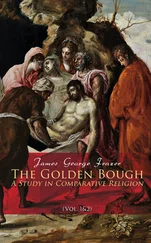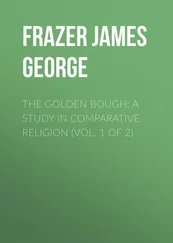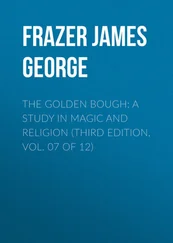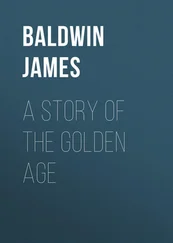“ We carry Death out of the village, We bring Summer into the village. ”
Here, as we shall see later on, the “Summer” is the spirit of vegetation returning or reviving in spring. In some parts of our own country children go about asking for pence with some small imitations of May-poles, and with a finely-dressed doll which they call the Lady of the May. In these cases the tree and the puppet are obviously regarded as equivalent.
At Thann, in Alsace, a girl called the Little May Rose, dressed in white, carries a small May-tree, which is gay with garlands and ribbons. Her companions collect gifts from door to door, singing a song:
“ Little May Rose turn round three times, Let us look at you round and round! Rose of the May, come to the greenwood away, We will be merry all. So we go from the May to the roses. ”
In the course of the song a wish is expressed that those who give nothing may lose their fowls by the marten, that their vine may bear no clusters, their tree no nuts, their field no corn; the produce of the year is supposed to depend on the gifts offered to these May singers. Here and in the cases mentioned above, where children go about with green boughs or garlands on May Day singing and collecting money, the meaning is that with the spirit of vegetation they bring plenty and good luck to the house, and they expect to be paid for the service. In Russian Lithuania, on the first of May, they used to set up a green tree before the village. Then the rustic swains chose the prettiest girl, crowned her, swathed her in birch branches and set her beside the May-tree, where they danced, sang, and shouted “O May! O May!” In Brie (Isle de France) a May-tree is erected in the midst of the village; its top is crowned with flowers; lower down it is twined with leaves and twigs, still lower with huge green branches. The girls dance round it, and at the same time a lad wrapt in leaves and called Father May is led about. In the small towns of the Franken Wald mountains in Northern Bavaria, on the second of May, a Walber tree is erected before a tavern, and a man dances round it, enveloped in straw from head to foot in such a way that the ears of corn unite above his head to form a crown. He is called the Walber, and used to be led in procession through the streets, which were adorned with sprigs of birch.
Amongst the Slavs of Carinthia, on St. George’s Day (the twentythird of April), the young people deck with flowers and garlands a tree which has been felled on the eve of the festival. The tree is then carried in procession, accompanied with music and joyful acclamations, the chief figure in the procession being the Green George, a young fellow clad from head to foot in green birch branches. At the close of the ceremonies the Green George, that is an effigy of him, is thrown into the water. It is the aim of the lad who acts Green George to step out of his leafy envelope and substitute the effigy so adroitly that no one shall perceive the change. In many places, however, the lad himself who plays the part of Green George is ducked in a river or pond, with the express intention of thus ensuring rain to make the fields and meadows green in summer. In some places the cattle are crowned and driven from their stalls to the accompaniment of a song:
“ Green George we bring, Green George we accompany, May he feed our herds well. If not, to the water with him. ”
Here we see that the same powers of making rain and fostering the cattle, which are ascribed to the tree-spirit regarded as incorporate in the tree, are also attributed to the tree-spirit represented by a living man.
Among the gypsies of Transylvania and Roumania the festival of Green George is the chief celebration of spring. Some of them keep it on Easter Monday, others on St. George’s Day (the twentythird of April). On the eve of the festival a young willow tree is cut down, adorned with garlands and leaves, and set up in the ground. Women with child place one of their garments under the tree, and leave it there over night; if next morning they find a leaf of the tree lying on the garment, they know that their delivery will be easy. Sick and old people go to the tree in the evening, spit on it thrice, and say, “You will soon die, but let us live.” Next morning the gypsies gather about the willow. The chief figure of the festival is Green George, a lad who is concealed from top to toe in green leaves and blossoms. He throws a few handfuls of grass to the beasts of the tribe, in order that they may have no lack of fodder throughout the year. Then he takes three iron nails, which have lain for three days and nights in water, and knocks them into the willow; after which he pulls them out and flings them into a running stream to propitiate the water-spirits. Finally, a pretence is made of throwing Green George into the water, but in fact it is only a puppet made of branches and leaves which is ducked in the stream. In this version of the custom the powers of granting an easy delivery to women and of communicating vital energy to the sick and old are clearly ascribed to the willow; while Green George, the human double of the tree, bestows food on the cattle, and further ensures the favour of the water-spirits by putting them in indirect communication with the tree.
Without citing more examples to the same effect, we may sum up the results of the preceding pages in the words of Mannhardt: “The customs quoted suffice to establish with certainty the conclusion that in these spring processions the spirit of vegetation is often represented both by the May-tree and in addition by a man dressed in green leaves or flowers or by a girl similarly adorned. It is the same spirit which animates the tree and is active in the inferior plants and which we have recognised in the May-tree and the Harvest-May. Quite consistently the spirit is also supposed to manifest his presence in the first flower of spring and reveals himself both in a girl representing a May-rose, and also, as giver of harvest, in the person of the Walber. The procession with this representative of the divinity was supposed to produce the same beneficial effects on the fowls, the fruit-trees, and the crops as the presence of the deity himself. In other words the mummer was regarded not as an image but as an actual representative of the spirit of vegetation; hence the wish expressed by the attendants on the May-rose and the May-tree that those who refuse them gifts of eggs, bacon, and so forth, may have no share in the blessings which it is in the power of the itinerant spirit to bestow. We may conclude that these begging processions with May-trees or May-boughs from door to door (‘bringing the May or the summer’) had everywhere originally a serious and, so to speak, sacramental significance; people really believed that the god of growth was present unseen in the bough; by the procession he was brought to each house to bestow his blessing. The names May, Father May, May Lady, Queen of the May, by which the anthropomorphic spirit of vegetation is often denoted, show that the idea of the spirit of vegetation is blent with a personification of the season at which his powers are most strikingly manifested.”
So far we have seen that the tree-spirit or the spirit of vegetation in general is represented either in vegetable form alone, as by a tree, bough, or flower; or in vegetable and human form simultaneously, as by a tree, bough, or flower in combination with a puppet or a living person. It remains to show that the representation of him by a tree, bough, or flower is sometimes entirely dropped, while the representation of him by a living person remains. In this case the representative character of the person is generally marked by dressing him or her in leaves or flowers; sometimes, too, it is indicated by the name he or she bears.
Читать дальше












